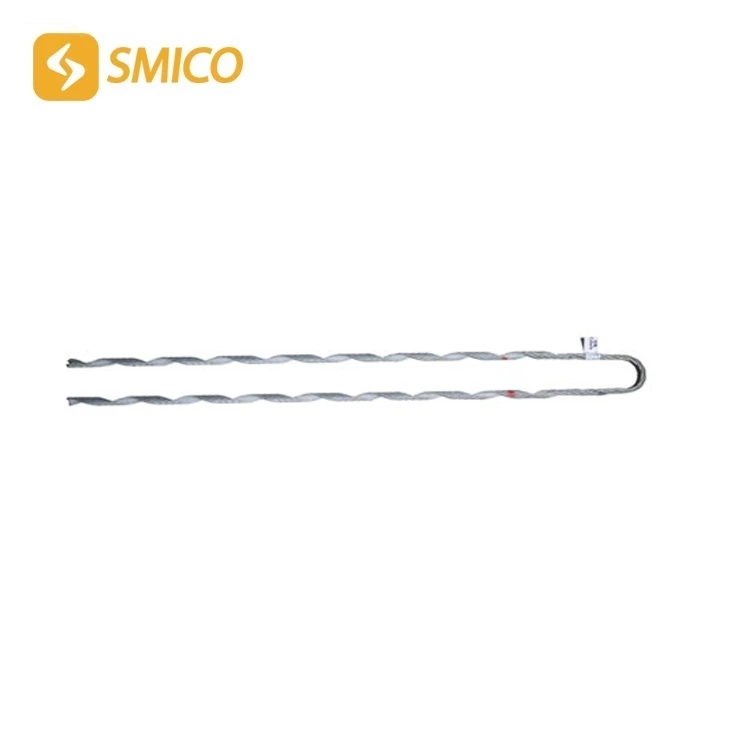Discussion On The Repair Method Of Broken Opgw Pre-twisted Wire
OPGW is different from ground wire. After the strands of armor rod preformed are broken or scattered, they cannot be disconnected and reconnected. It can only be repaired by replacing a tension section of OPGWpreformed armour rod. Due to the power outage time, it is difficult for the operation and maintenance department to replace the optical cable.
Generally speaking, the mechanical strength of OPGWarmor rods has a certain margin, which is guaranteed by the safety factor between the breaking tension of the optical cable and the operating tension. As long as the broken strands have little impact on the safety factor, we believe that it can be reinforced and repaired by a certain repair method and continued to be used.
1. Conditions for repairing OPGW broken strands armor rods for acsr
Under what conditions can OPGW be repaired after the strands are broken? Is the repair for temporary use or permanent use? It is a hot topic under discussion at present, and there is no unified conclusion. Since there is no "operation and maintenance regulations" for OPGW at present, what kind of judgment conditions need to be discussed.
According to the requirements for repair and reinforcement of ground wires in the "Transmission Line Operation and Maintenance Regulations", when the damaged cross-section of the broken strands of steel-core aluminum stranded wire or aluminum alloy stranded wire is less than 25% of the total area of the aluminum strands, and the damaged cross-section of the broken strands of steel stranded wire or aluminum-clad steel stranded wire is less than 17% of the total area, it can be repaired and reinforced for use. At present, there is also a view that OPGW with 1∽2 strands broken can be repaired. Another view is to refer to the OPGW standards IEC 60794-4-1 and DL/T 832-2003 for "OPGW short-circuit current test, then subjected to tensile test, should be able to withstand a tensile force of not less than 75%RTS without any damage or breakage of components." and "OPGW The residual tensile strength of the unbroken strands calculated after the lightning test should be not less than 75%RTS" test requirements, and use the method of calculating the residual tensile strength after the strand is broken to verify. According to the above description, we can consider whether to repair based on the number of broken strands, the cross-sectional area of broken strands, and the strength of broken strands. However, for the single-layer central tube structure OPGW with 6 and 7 outer layers of armor rods transmission line, the residual tensile strength and residual cross-section after breaking 2 strands do not meet the requirements of broken strand strength and broken strand cross-sectional area. Therefore, for all OPGW structures, it is inappropriate to use the judgment condition of the number of broken strands. Since the direct consequence of OPGW armour rod strand breaking is the reduction of OPGW armour rod in transmission line mechanical strength and the loss of current-carrying cross-sectional area, and the mechanical strength and cross-sectional area can be restored after repair, the judgment conditions of broken strand cross-sectional area and broken strand strength cannot be treated in isolation, and it is most appropriate to combine them. In summary, if the following conditions are met at the same time, permanent repairs can be made using applicable methods:
(1) The residual tensile strength of the unbroken strands after the OPGW armor rods conductor is broken is not less than 75% RTS;
(2) The damaged cross-section of the broken aluminum alloy strand is less than 25% of the total area of the aluminum alloy strand, and the damaged cross-section of the broken aluminum clad steel strand is less than 17% of the total area of the aluminum clad steel strand;
(3) Use appropriate methods (such as B-OTDR) to prove that the optical fiber is strain-free and the optical signal transmission is not damaged;
If the above three conditions are not met at the same time, only necessary and temporary maintenance methods can be taken to enable the OPGW to continue to be used,
to avoid further expansion of the fault or serious consequences.

